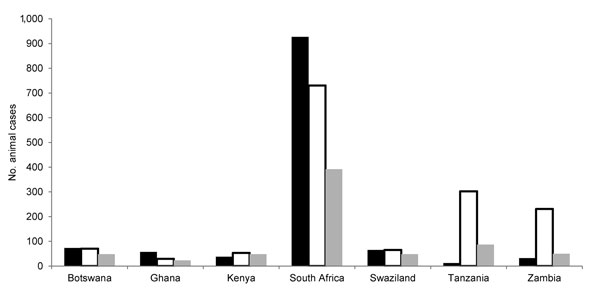Volume 19, Number 4—April 2013
Perspective
Discrepancies in Data Reporting for Rabies, Africa
Figure 1

Figure 1. . . Number of rabies cases in animals reported in 2007 from countries in Africa classified as developing countries. Data were obtained from Southern and Eastern African Rabies Group reports (black bars), the World Health Organization (Rabnet) (21) (white bars), and the World Organisation for Animal Health World Animal Health Information Database (gray bars).
References
- Streicker DG, Recuenco S, Valderrama W, Gomez Benavides J, Vargas I, Pacheco V, Ecological and anthropogenic drivers of rabies exposure in vampire bats: implications for transmission and control. Proc Biol Sci. 2012;279:3384–92. DOIPubMedGoogle Scholar
- Nel LH, Rupprecht CE. The emergence of lyssaviruses in the old world: the case of Africa. Curr Top Microbiol Immunol. 2007;315:161–93. DOIPubMedGoogle Scholar
- World Health Organization. WHO rabies epidemiology; 2012 [cited 2012 Dec 6]. http://www.who.int/entity/rabies/rabies_maps/en/index.html
- Marston DA, Horton DL, Ngeleja C, Hampson K, McElhinney LM, Banyard AC, Ikoma lyssavirus, highly divergent novel lyssavirus in an African civet. Emerg Infect Dis. 2012;18:664–7. DOIPubMedGoogle Scholar
- Kuzmin IV, Mayer AE, Niezgoda M, Markotter W, Agwanda B, Breiman RF, Shimoni bat virus, a new representative of the lyssavirus genus. Virus Res. 2010;149:197–210. DOIPubMedGoogle Scholar
- World Health Organization. WHO fact sheet number 99; 2010 [cited 2011 Jul 21]. http://www.who.int/mediacentre/factsheets/fs099/en/index.html
- Cohen C, Sartorius B, Sabeta C, Zulu G, Paweska J, Mogoswane M, Epidemiology and molecular virus characterization of re-emerging rabies, South Africa. Emerg Infect Dis. 2007;13:1879–86. DOIPubMedGoogle Scholar
- Mallewa M, Fooks AR, Banda D, Chikungwa P, Mankhambo L, Molyneux E, Rabies encephalitis in malaria-endemic area, Malawi, Africa. Emerg Infect Dis. 2007;13:136–9. DOIPubMedGoogle Scholar
- Gadre G, Satishchandra P, Mahadevan A, Suja MS, Madhusudana SN, Sundaram C, Rabies viral encephalitis: clinical determinants in diagnosis with special reference to paralytic form. J Neurol Neurosurg Psychiatry. 2010;81:812–20. DOIPubMedGoogle Scholar
- Buyuk Y, Uzun I, Aybar Y, Kurnaz G, Ozaras R. Rabies in Turkey: three human cases illustrating the importance of suspecting exposure. Wilderness Environ Med. 2007;18:214–7 and. DOIPubMedGoogle Scholar
- Hatfield G. Encyclopedia of folk medicine: old world and new world traditions. Santa Barbara (CA): ABC-CLIO; 2004.
- Mahawar MM, Jaroli DP. Traditional knowledge on zootherapeutic uses by the Saharia tribe of Rajasthan, India. J Ethnobiol Ethnomed. 2007;3:25. DOIPubMedGoogle Scholar
- Pankhurst R. The history and traditional treatment of rabies in Ethiopia. Med Hist. 1970;14:378–89. DOIPubMedGoogle Scholar
- Blancou J. Rabies in Europe and the Mediterranean basin: from antiquity to the 19th century. In: King AA, Fooks AR, Aubert M, Wandeler AI, editors. Historical perspective of rabies in Europe and the Mediterranean basin. Paris: Organisation for Animal Health; 2004. p. 15–23.
- Zeng H, Pappas C, Katz JM, Tumpey TM. The 2009 pandemic H1N1 and triple-reassortment swine H1N1 influenza viruses replicate efficiently but elicit an attenuated inflammatory response in polarized human bronchial epithelial cells. J Virol. 2011;85:686–96. DOIPubMedGoogle Scholar
- Knobel DL, Cleaveland S, Coleman PG, Fèvre EM, Meltzer MI, Miranda ME, Re-evaluating the burden of rabies in Africa and Asia. Bull World Health Organ. 2005;83:360–8 .PubMedGoogle Scholar
- World Health Organization. WHO expert consultation on rabies. World Health Organ Tech Rep Ser. 2005;931:1–88 .PubMedGoogle Scholar
- World Health Organization. WHO global health atlas; 2011 [cited 2011 Jul 21]. http://apps.who.int/globalatlas/dataQuery/default.asp
- World Organisation for Animal Health. WAHID interface—OIE world animal health information database; 2011 [cited 2011 Jul 21]. http://web.oie.int/wahis/public.php?page=home
- World Organisation for Animal Health. Strategic plan: World Organisation for Animal Health; 2011 [cited 2011 Jul 21]. http://www.oie.int/about-us/director-general-office/strategic-plan/
- Schneider MC, Belotto A, Adé MP, Hendrickx S, Leanes LF, Rodrigues MJ, Current status of human rabies transmitted by dogs in Latin America. Cad Saude Publica. 2007;23:2049–63. DOIPubMedGoogle Scholar
- Nel LH, Le Roux K, Atlas R. Rabies control program in South Africa. Microbe. 2009;4:61–5.
- Food and Agriculture Organization of the United Nations. Animal Production and Health Division; 2012 [cited 2012 Jan 20]. http://www.fao.org/ag/againfo/home/en/news_archive/2011_Tripartite_against_Diseases.html.
Page created: March 13, 2013
Page updated: March 13, 2013
Page reviewed: March 13, 2013
The conclusions, findings, and opinions expressed by authors contributing to this journal do not necessarily reflect the official position of the U.S. Department of Health and Human Services, the Public Health Service, the Centers for Disease Control and Prevention, or the authors' affiliated institutions. Use of trade names is for identification only and does not imply endorsement by any of the groups named above.